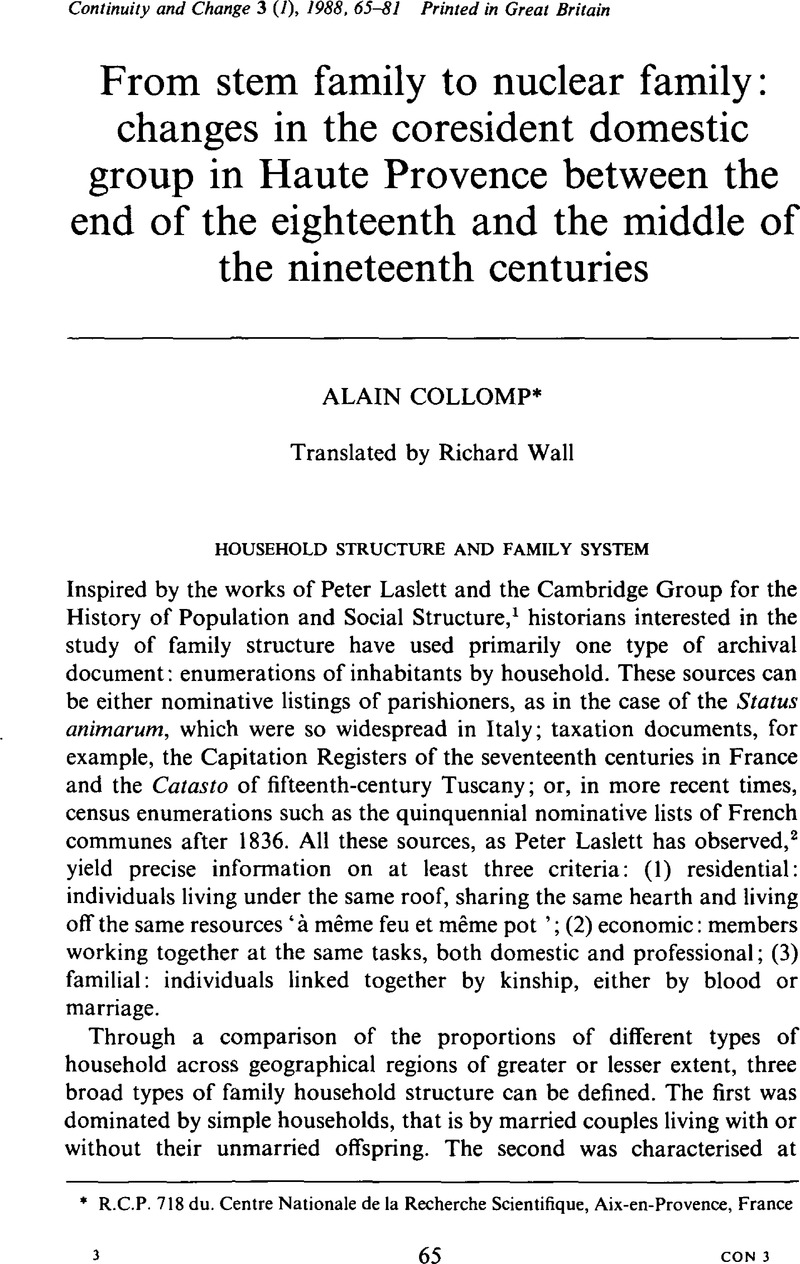Published online by Cambridge University Press: 29 January 2009

1 Laslett, Peter, ‘Analytic introduction on the history of the family’ in, Household and family in past time (Cambridge, 1972).CrossRefGoogle Scholar
2 Ibid.
3 Collomp, A., ‘Famille nucléaire et famille élargie en Provence au XVIIIème siecle’, Annales ESC, 27 4/5, (1972)Google Scholar and Collomp, A., ‘La maison du père, famille et village en Haute-Provence aux XVIIeme el XVIIIeme siècle (Paris, 1983).Google Scholar
4 Saint-André-les-Alpes is today the administrative centre of a canton in the arrondissement of Castellane in the department of Alpes-de-Haute-Provence.
5 Before the Revolution, men came of age at 30 and women at 25. But full age did not automatically mean the son's emancipation. An unemancipated male could not make a will or enter any contract. According to eighteenth-century Provencal lawyers there also existed a form of incomplete, de facto, emancipation that could be obtained without the parent's agreement if the son had left the parental home for more than 10 years; this case of course did not apply to the chosen heir, the ‘son of the family’.
6 Collomp, A., ‘Alliance et filiation en Haute-Provence au XVIIIeme siècle’, Annales ESC 32 3 (1977).Google Scholar
7 On the other hand, Pierre Lamaison found that as many as 43 per-cent of all heirs were female in the marriage contracts drawn up in the eighteenth century in Ribennes-en-Gévaudan, in Lozère. Lamaison, P., ‘Les stratégies matrimoniales dans un système complexe de parenté: Ribennes-en-Gévaudan (1650–1830)’, Annales ESC, 34, 4 (1979).Google Scholar In the valleys of the Pyrénées, particularly in the valley of Barèges, the custom was always to choose the eldest child as the heir, whether the child was male or female.
8 Berkner, L., ‘Inheritance land tenure and peasant family structure: A German regional comparison’, in Goody, J. and Thompson, E. P., ed., Family and inheritance (Cambridge, 1976).Google Scholar
9 Duby, Georges, The knight, the lady and priest: the making of modern marriage in medieval France (London, 1983).Google Scholar
10 For example, a sampling of notary archives from the town of Guillaumes revealed that the marriage and succession practices that applied to the whole of Haute Provence did not change after the area was annexed to the Comté de Nice in 1760.
11 For an account of all the censuses preserved in the departmental archives of the Alpes Maritimes at Nice, see Devun, J., ‘Les dénombrements de la population et les communautés du Comte de Nice au XVIIIeme siècle’, in Actes du 90eme congrès national des Sociétés savantes (Section d'histoire moderne et contemporaine) 1 (Paris, 1966).Google Scholar
12 Guillaumes is the administrative centre of a canton in the arrondissement of Nice in the department of the Alpes-Maritimes.
13 This classification does not in fact follow the strict tenets of the Laslett typology which is based only on the kin structure of the household. Persons coresiding with unrelated servants would therefore be classified by Laslett as ‘solitaries’.
14 The quote comes from the French version of Peter Laslett's introduction to Household and family in past time: ‘La famille et le ménage: approches historiques’, Annales ESC 27 4/5 (1972).Google Scholar
15 This marks another departure from the Laslett typology which calculates the direction of the extension from the conjugal family unit as opposed to the household head, as in the present case.
16 Archives départementales des Alpes-de-Haute-Provence, série 6M.
17 Fauve-Chamoux, A., ‘Les structures familiales au royaume des familles-souches: Esparros’, Annales ESC 39 3 (1984).Google Scholar
18 Mistral, M.: L'Industrie drapière dans la vallée du Verdon (Nice, 1951).Google Scholar
19 Archives departementales des Alpes-de-Haute-Provence, série M. 12, art. 14.
20 The Napoleon Code Civil drawn up in 1804 established equality between all male and female heirs when the parents had not written out a will. Before the Revolution, if the parents had not written a will, the family property was equally divided between the sons who nevertheless had to devolve upon their sisters a small part of the holdings (’ la legitime?’). However, in order not to force the immediate dissolution of the stem-family system the Code Civil granted parents the right to give preferential treatment to one of their children who could thus be endowed with one quarter of the family property before the rest was divided.
21. Mendels, F., ‘Industrialisation and population pressure in eighteenth-century Flanders (University of Wisconsin, 1969).Google Scholar